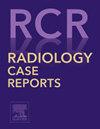嗜酸性肉芽肿:自发性消退1例报告
Q4 Medicine
引用次数: 0
摘要
嗜酸性肉芽肿(EG)是朗格汉斯细胞组织细胞增多症(LCH)的一种形式,具有良性和自限性病程,最常见于儿童和年轻人。本病例描述了一名33岁的女性,她报告了左髂和臀区3个月的疼痛史,服用非甾体抗炎药(NSAIDs)后疼痛有所改善。磁共振成像(MRI)显示左侧髂骨有一个孤立的溶骨性病变,并伴有骨水肿,随后活检。报告证实了EG的诊断,发现朗格汉斯细胞S100蛋白阳性。在活检后1年的过程中,观察到一个渐进的自发解决,没有任何干预,除了症状管理。本病例是一例罕见的成年女性嗜酸性肉芽肿(EG),磁共振成像(MRI)技术评估,活检检查后自发消退。我们将讨论临床表现,影像学表现和治疗。本文章由计算机程序翻译,如有差异,请以英文原文为准。
Eosinophilic granuloma: Case-report of spontaneous resolution
Eosinophilic granuloma (EG) is one of the forms of Langerhans cell histiocytosis (LCH) with a benign and self-limiting course that most commonly affects children and young adults. This case describes a 33-year-old woman who reported a history of pain localized in the left iliac and gluteal region for 3 months, which improved with the administration of nonsteroidal anti-inflammatory drugs (NSAIDs). Magnetic resonance imaging (MRI) revealed a solitary osteolytic lesion in the left iliac bone with associated bone edema that subsequently was bioptized. The report confirmed the diagnosis of EG with identification of Langerhans cells positive for S100 protein. A progressive spontaneous resolution over the course of 1 year after the biopsy was observed, without any intervention beyond symptomatic management. This case highlights a rare case of an eosinophilic granuloma (EG) in an adult woman evaluated with magnetic resonance imaging (MRI) technique, which was resolved spontaneously following the biopsy examination. We will discuss the clinical presentation, radiological findings and treatment.
求助全文
通过发布文献求助,成功后即可免费获取论文全文。
去求助
来源期刊

Radiology Case Reports
Medicine-Radiology, Nuclear Medicine and Imaging
CiteScore
1.10
自引率
0.00%
发文量
1074
审稿时长
30 days
期刊介绍:
The content of this journal is exclusively case reports that feature diagnostic imaging. Categories in which case reports can be placed include the musculoskeletal system, spine, central nervous system, head and neck, cardiovascular, chest, gastrointestinal, genitourinary, multisystem, pediatric, emergency, women''s imaging, oncologic, normal variants, medical devices, foreign bodies, interventional radiology, nuclear medicine, molecular imaging, ultrasonography, imaging artifacts, forensic, anthropological, and medical-legal. Articles must be well-documented and include a review of the appropriate literature.
 求助内容:
求助内容: 应助结果提醒方式:
应助结果提醒方式:


